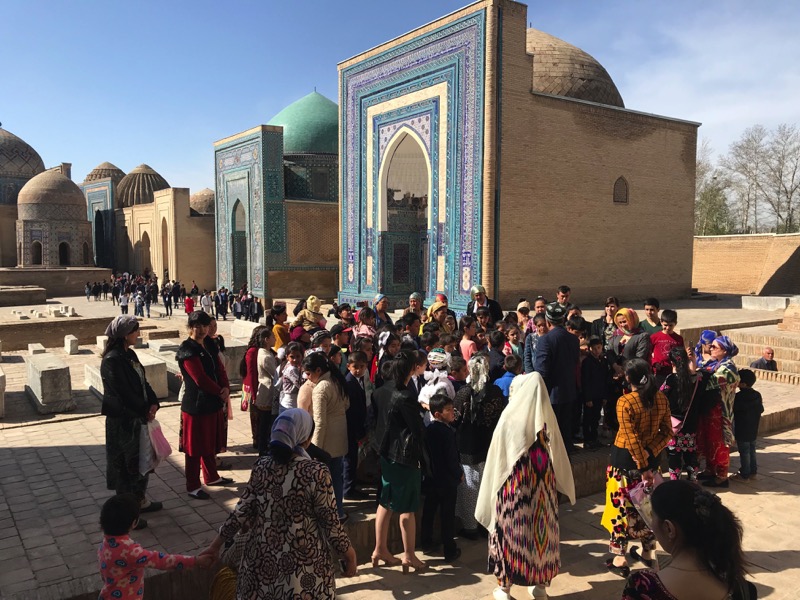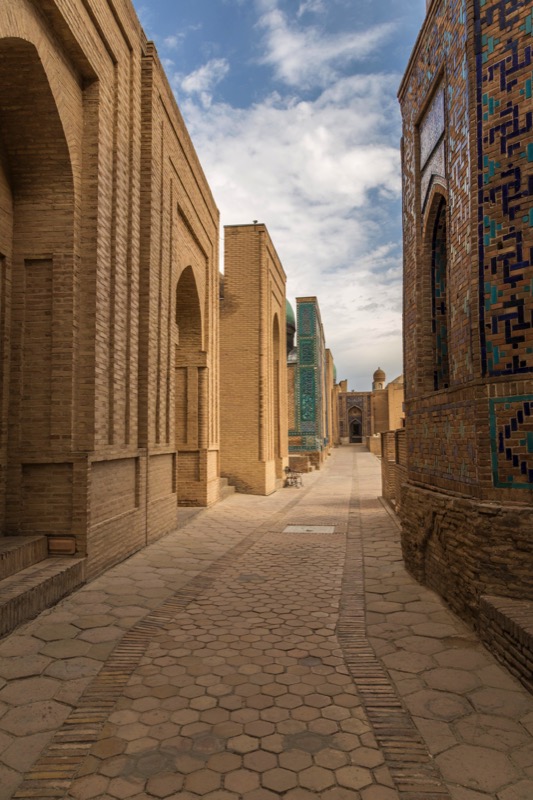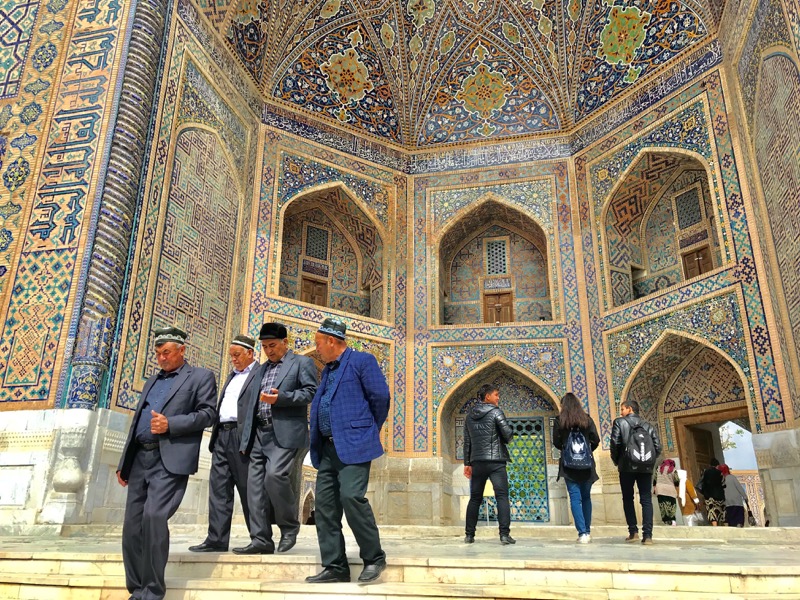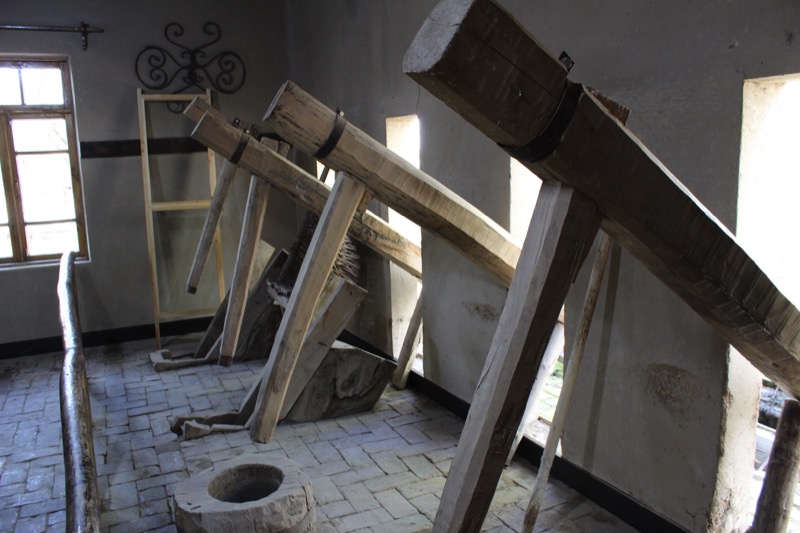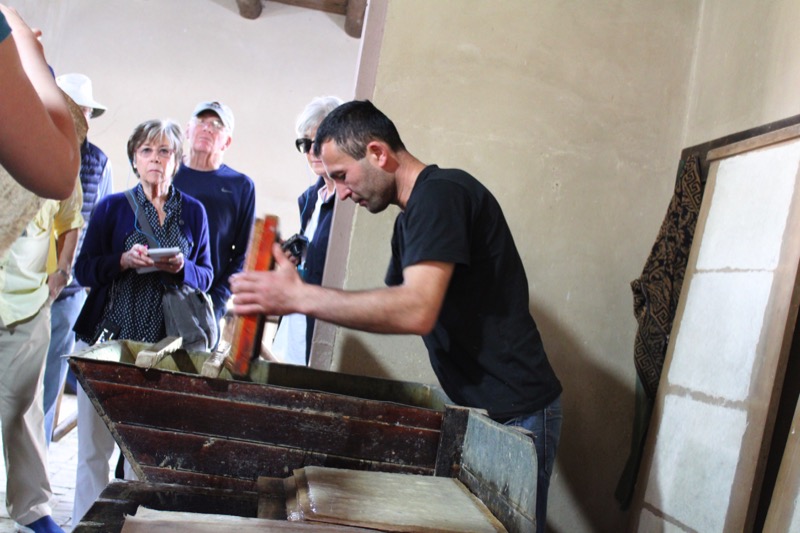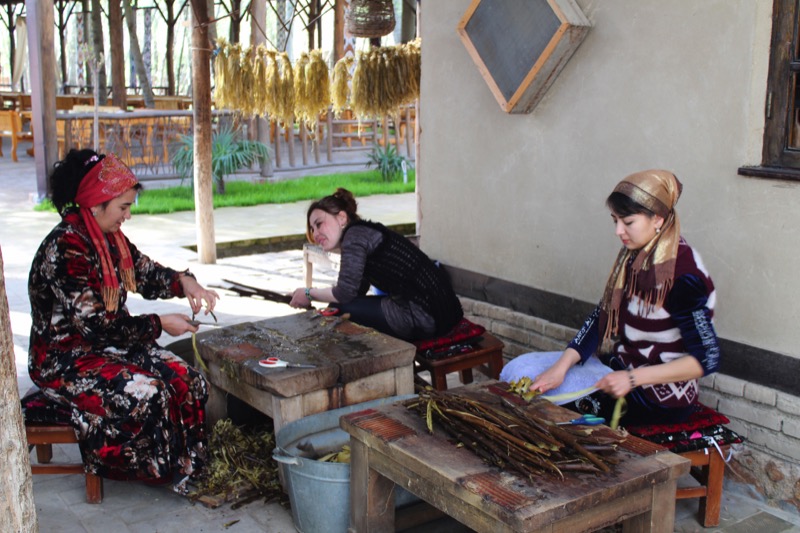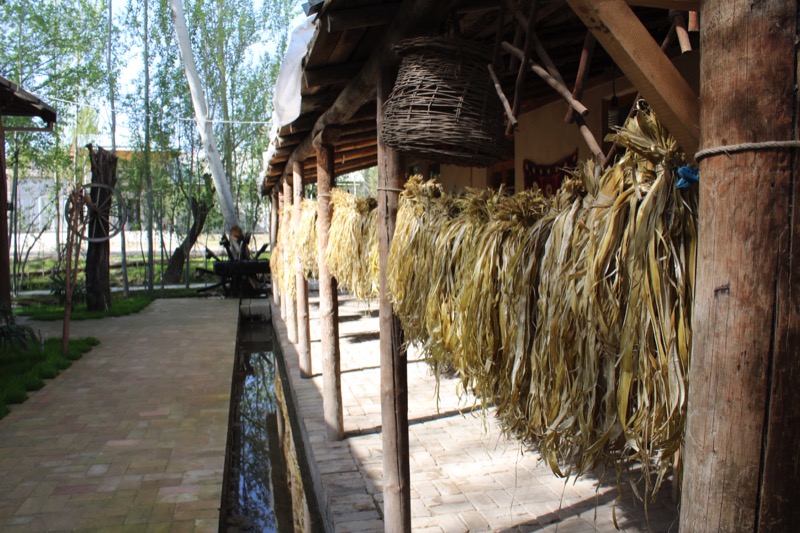Abdu Samadov is a Samarkand native with a treasure trove of knowledge about his hometown and about Uzbekistan. Abdu studied in England and the U.S. and is fluent in English, Farsi, and Russian. He guides MIR travelers throughout Central Asia and enjoys sharing his insights and experiences with others.
Here, Abdu offers his insider tips on exploring the legendary oasis city of Samarkand like a local.
Perhaps the most well known of Silk Road towns, Samarkand, the fabled oasis on the fringes of the Kyzyl Kum Desert, has been settled since the 6th century BC. Its strategic location between China and the Western world secured its importance as a center for trade and cultural exchange, and made it an attractive target for famous conquerors, including Alexander the Great, Genghis Khan, and Tamerlane, who made it his capital city.
Everyday life at the graceful Registan in Samarkand
Photo credit: Michel Behar
Assembling the finest architects and artisans of the time, Tamerlane and his grandson, Ulug Bek, transformed the city into a stunning treasure trove of decorative art and architecture. Today a UNESCO World Heritage Site, Samarkand bears the indelible stamp of these two men, and their legacy can be found in such extraordinary monuments as majestic Registan Square, the Bibi-Khanum Mosque, and the avenue of ancient mausoleums called Shah-i-Zinda.
(click on photo for larger version)
With such astounding architectural brilliance, it's no wonder that Samarkand still holds near mythical status for many modern-day travelers. But while its glittering mosques and madrassahs are important to understanding the region's rich history and artistic heritage, your travel experiences will be much more rewarding and memorable when you veer a little off the beaten tourist track and dive right into the ways of everyday local life.
Visitors mingle with locals at Shah-i-Zinda Complex in Samarkand, Uzbekistan
Photo credit: Abdu Samadov
You'll not only discover unique hidden gems, but also enjoy more opportunities to connect with the culture and experience the real heart of Samarkand's timeless character. Here are just a few of my favorite ways to explore the legendary Silk Road oasis of Samarkand like a local would.
Shah-i-Zinda, or “Place of a Living King,” is a stunning avenue of mausoleums containing the tombs of Samarkand’s royal and noble elite
Photo credit: Bill Fletcher
Discover the Spiritual Side of Shah-i-Zinda
The row of tombs and mausoleums collectively called Shah-i-Zinda, or “place of a living king,” stretches between the present and the past. At its front is living Samarkand, and at its back the dusty slopes at the edge of ancient Afrosiab. Even on hot summer days the mausoleums remain shady and cool, and seem to lure the traveler to approach the oldest tomb at the far end. Behind the complex and set into the hill lies an active cemetery with grave sites dating back as far as the 9th century, and as recently as the present day.
Locals gather at Shah-i-Zinda
Photo credit: Abdu Samadov
Shah-i-Zinda is a favorite tourist site, but it's also an important place of pilgrimage for today's Uzbeks. Many come here by the thousands each day to pay their respects to past leaders and historic figureheads of the city. One place inside the complex where you can see ancient traditions at work is at the grave of Qusam ibn-Abbas, a cousin of the prophet Mohammad who was believed to be the first person to bring Islam to the region. If you have some time to spare, sit on one of the benches nearby and watch as locals perform special blessings and pilgrimage rituals.
(click on photo for larger version)
During such rituals, an imam will recite a series of special prayers or songs — the acoustics generated between the mausoleum walls amplifies voices to an even greater level. Men and women open their palms during the blessing ritual, which they believe allows them to gather positive energy to purify themselves. This is a unique experience for visitors to observe, and allows you to get a deeper insight into the everyday customs and culture of the local people.
Elders wandering among the grave sites can often be seen dressed in traditional costumes. I always encourage MIR travelers to strike up a conversation with them if they can — they are friendly, open to chatting with visitors, and love posing for photos, making this a great site for portrait photography.
Tree-lined avenues of Samarkand’s Russian (or Colonial) Quarter
Photo credit: Abdu Samadov
Admire Turn-of-the-Century Architecture in the Colonial Quarter
Because of Samarkand's favorable geopolitical location on the Silk Route, the city saw its fair share of conflicts between various khanates in Central Asia and global empires abroad. The last foreign power to rule here was Russia, which conquered the city in 1887 and made it a provincial capital.
St. John the Baptist Church in Samarkand’s old Colonial Quarter
Photo credit: Abdu Samadov
Beginning from the late 19th century and continuing into the 20th, Samarkand entered a new stage of development as Russian architects built an entirely new quarter west of the Old Town, today known as the Russian, or Colonial, Quarter. Blending local materials with colonial-style architecture, the Russians built schools, universities, hospitals, and shopping malls, as well as the Trans-Caspian Railway, which transported valuable Caspian oil reserves through Samarkand en route to Moscow.
The Colonial Quarter is a popular hangout for local university students, and full of unique turn-of-the-century buildings
Photo credit: Abdu Samadov
Hidden away from the more heavily visited tourist areas, the Colonial Quarter is a fantastic place to interact with locals, enjoy a moment of quiet, and learn about a very different, though equally important, part of Samarkand's history.
I recommend starting with a walk around University Boulevard. Built by Russian general Alexander Konstantinovich Abramov, the boulevard is lined with turn-of-the-century university campus buildings and schools. Local students often come here for a walk or just to sit and relax on the benches. You may also see a few wedding parties strolling through the parks and green spaces, as they are popular places for photography.
Another place you may wish to explore is the Museum of Local Lore, housed in the former home of a Jewish merchant. The museum's interior contains wonderful examples of local art and craftsmanship, including a room covered in intricately carved and painted plasterwork known as ganche, as well as a small exhibit with old photos, books, and everyday objects from Samarkand's once flourishing Jewish community.
St. Aleksey Church is the heart of Samarkand’s Eastern Orthodox community
Photo credit: Michel Behar
Don’t forget to check out the quarter's Eastern Orthodox and Catholic church buildings. The Colonial Quarter has several well-preserved cathedrals that date back to the city's czarist era, including the Orthodox St. Aleksey Church and St. John the Baptist Church. Nearby, you'll find two popular cafes, Coffee Time and Cafe Magistr, where you can drink good European-style coffee while meeting and chatting with local university students. Be prepared to walk about 3 miles and spend 2 hours of your time for a walking tour in the Colonial Quarter.
The entrance of Urgut Market
Photo credit: Douglas Grimes
Shop the Ancient Silk Road in Urgut
Samarkand is a wonderful place to buy authentic Silk Road souvenirs. While the local Siab Bazaar is fantastic, I recommend going off the beaten tourist track to browse the labyrinthine Urgut Market, located in the town of Urgut, about an hour's drive away. This is old Samarkand, without the flash and modernized updates of the city, where merchants and shoppers may greet you with surprise and delight simply because you’re a foreigner.
Colorful textiles at the Urgut Market
Photo credit: Douglas Grimes
A fabulous place to people-watch, the Urgut Market draws local people, and a few foreigners, from miles around. Yes, cheap plasticware and synthetic clothing from China is available if that’s what you need, but hidden away behind these everyday items are the wonderful textiles and adornments of the Silk Road.
(Click on photo for larger version)
Stalls spill from the covered area to form wandering lanes way out in the open air, where women draped in ikat robes and men in black and white tubeteika caps sell their handcrafted wares. Sumptuous suzani, the finely embroidered coverlets that Uzbek women have designed and created for hundreds of years, are handed down for inspection with long poles. Nearby, hundreds of brilliant quilted, tasseled, beaded, and embroidered caps display themselves like flowers.
Hiking through glorious greenery in the Gissar Mountains
Photo credit: Abdu Samadov
Go for a Hike in the Gissar Mountains
Samarkand's sheer brilliance of tilework is absolutely stunning, but it can also be overwhelming and at times crowded with other travelers. If you need a peaceful escape from the bustling city and have extra time to spare, head for the nearby foothills of the Gissar Mountain Range.
Gissar’s otherworldly rock formations were eroded over time by water and wind
Photo credit: Abdu Samadov
The Gissar Mountains form the western portion of the Pamir Alay Range, and can be reached via an hour’s drive south of Samarkand by car. Dotted with unusual granite, sandstone, and crystalline rock formations, Gissar’s landscape shifts remarkably as you move further west, changing from sprawling grasslands, to rugged mountain canyons, to colossal weathered peaks. The diverse landscape makes it a wonderful place to go for a day hike, and it’s also possible to spot native wildlife such as the Tien Shan brown bear, snow leopard, Turkestan lynx, or golden eagle.
A peaceful brook in the Gissar Mountains
Photo credit: Abdu Samadov
The Gissar Range is also a great place to get a taste of rural life outside the major caravan cities of Uzbekistan and Central Asia. This area has been inhabited since the time of Alexander the Great, and many villagers still live and farm on the fertile lands here much as their ancestors did centuries ago.
I recommend visiting the villages of Ohalik and Aman-Kutan. Both places are conveniently located close to hiking trails, and you’ll have a chance to meet with villagers and visit their traditional homes built of local stone. The locals here are friendly, and often invite travelers to chat with them and learn more about their daily lives and about the plants and animals that graze the area. Having the support of local tour guides is key, as it will provide you with a much deeper learning experience and interaction with the shepherds, village farmers, and ordinary people of the region.
The Registan is even more beautiful during the “blue hours” of twilight
Photo credit: Abdu Samadov
Bask in the Glow of Samarkand’s “Blue Hours”
The Silk Road is brimming with iconic sights that travelers love to photograph, and Samarkand is no exception. Most come to see these majestic tile-wrapped monuments during the daytime, but to truly capture Samarkand’s legendary beauty, you simply must experience it before dawn or after dusk during the “blue hours” of twilight.
Moonrise over the majestic Registan
Photo credit: Douglas Grimes
The streets are much quieter during these hours, which gives you an opportunity to take in the sights without the heavy crowds — you may even feel like you have the entire city to yourself as you walk around. In the evenings once the sun goes down, many landmarks will be illuminated with special LED lights, adding a striking pop of color to the desert squares.
Here are three must-visit places I encourage travelers to explore and photograph during Samarkand’s beautiful “blue hours”:
The sky blushes pink during a Samarkand sunrise
Photo credit: Willis Hughes
Registan Square: Registan Square is the centerpiece of Samarkand, and the most recognizable landmark for visitors. The three emblematic madrassahs frame the square, and loom over the empty space in the center. It was this central space that originally gave the place its name, for “registan” simply means “place of sand.” This sandy place was at the center of ancient Samarkand and was a public square and marketplace before the Ulug Bek, Tillya-Kori, and Shir Dor madrassahs were built. In its reconstruction, the square maintains the majesty that it has radiated through the ages.
Golden sunset over Samarkand’s Gur-Emir Mausoleum
Photo credit: Willis Hughes
Gur-Emir Mausoleum: Gur-Emir Mausoleum is the final resting place of Tamerlane, but was originally built for his grandson after the latter’s death, at the turn of the 15th century. The interior of the mausoleum has been restored and is brilliant in gold leaf and fresh tile. The heavily gilded central dome opens over the set of tomb-markers resembling sarcophagi (the bodies are located well below, but are on site). All are marble, with the exception of Tamerlane’s, which is a slab of solid jade reportedly from Mongolia.
Samarkand’s 15th century Bibi Khanum Mosque was a marvel of structural engineering for its time
Photo credit: Abdu Samadov
Bibi Khanum Mosque: Visit the Bibi Khanum Mosque, built by Tamerlane to be the largest mosque in the Islamic world, and dedicated to the memory of his favorite wife. Architects from India and Persia were brought in to build the mosque, and it is said that 95 elephants were used to transport the marble and other building materials from India to Samarkand.
Expert Tip: Capturing photos in low light can be a little tricky for novice photographers, so if you want to have more lighting, I recommend walking during the “golden hours” of dawn or dusk instead — you’ll still be able to snap plenty of great photos, and you can also see many locals walking the streets of the Old Town and enjoying the sights.
Handmade paper from Samarkand is carefully polished with shells or stone to create a smooth surface
Photo credit: Willis Hughes
Learn About the Traditional Craft of Paper-making
Uzbek crafts are some of the most vibrant and authentic in Central Asia, and many items are still produced by hand using traditional methods. For centuries, Samarkand’s specialty was paper-making, and today’s visitors can see this extraordinary handicraft being made the old-fashioned way in the workshops of local artisans.
(Click on photo for larger version)
Paper-making began in Samarkand over 1,000 years ago, when it was thought to have been learned from the Chinese. Local craftsmen adapted the Chinese production process to make better use of regional raw materials, substituting hardy mulberry bark for bamboo fiber, and polishing each individual piece of paper to create a smoother surface for ink-writing.
The result was an incredibly strong and long-lasting paper that became renowned throughout the Islamic world for its high quality. Even Babur, a descendant of Tamerlane and founder of the Mughal Empire in Northern India, was known to have praised Samarkand’s prized paper crafts, once noting that, “The world’s best paper is produced in Samarkand.”
You can learn more about Samarkand’s traditional paper crafts during a visit to a workshop where handcrafted paper is made according to traditions handed down from the 8th century. Founded in 1997 with the support of UNESCO, the workshop of Abdurakhim Mukhtarov, located in the village of Koni Gil on the outskirts of Samarkand, produces lovely paper crafts and stationery as you watch.
Stacks of postcards in Central Asia
Photo credit: Abdu Samadov
Postcards from Samarkand
Many travelers have read stories about Samarkand during their early childhood years, and even hearing the name of the city today can conjure those same evocative feelings. Having an opportunity to explore the city and see its sublime architecture the same way it must have been centuries ago is, as they tell me, a dream come true.
Many Samarkand postcards depict the city’s most famous landmarks, such as the Registan and Gur-Emir Mausoleum
Photo credit: Abdu Samadov
Not far from Gur-Emir there is an old house that was built during the communist years — it has a courtyard and some rooms reminiscent of a typical neighborhood home in Samarkand during the Soviet era. Today, it accommodates a very cozy self-service post office. Here, you can choose from a wide selection of postcards, buy unique stamps, and mail cards and souvenirs to friends and family at home.










